1. NPS to UPS: Government Extends One-Time Option – Economy
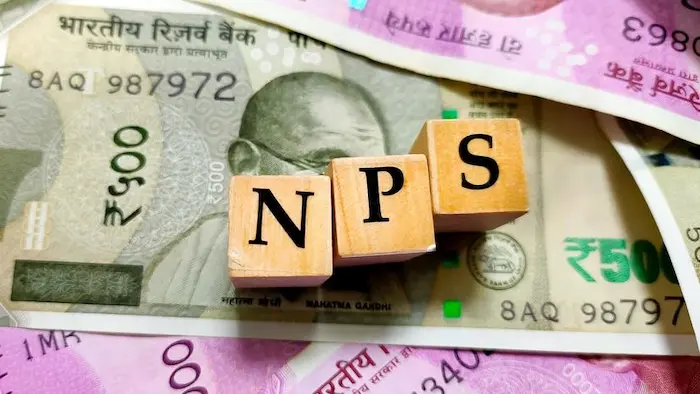
Why in News?
The Central Government has extended the deadline for eligible central government employees to opt for the Unified Pension Scheme (UPS) under the National Pension System (NPS) until September 30, 2025. This comes after a significantly low uptake — only about 40,000 out of 23.94 lakh eligible employees have opted for the scheme.
On September 2, 2025, the Department of Pension and Pensioners’ Welfare notified the Central Civil Services (Implementation of the Unified Pension Scheme under the National Pension System) Rules, 2025, to regulate the transition process.
What is the Unified Pension Scheme (UPS)?
The Unified Pension Scheme (UPS) is a new pension model introduced in April 2025 for central government employees under the NPS framework. It aims to bridge the gap between the NPS and the Old Pension Scheme (OPS) by offering partial guarantees and improved financial security.
Key Features of the UPS:
| Feature | Unified Pension Scheme (UPS) | National Pension System (NPS) | Old Pension Scheme (OPS) |
|---|---|---|---|
| Applicability | Employees joining between Apr 1–Aug 31, 2025 | All employees joining after Jan 1, 2004 | Employees who joined before Jan 1, 2004 |
| Pension Type | Guaranteed 50% of average basic pay of last 12 months (min. ₹10,000/month) | Market-linked, no guaranteed payout | Defined benefit, fixed pension |
| Eligibility for Pension | Minimum 25 years of service | Based on contribution & annuity returns | Minimum 10 years of service |
| Employee Contribution | 10% | 10% | None |
| Employer Contribution | 10% + 8.5% from Govt | 14% | Entire pension borne by govt |
| Minimum Pension | ₹10,000/month (after 10 years of service) | No minimum guaranteed | Fixed based on last pay drawn |
Switching Rules:
- UPS subscribers can switch to NPS once, but cannot return to UPS.
- Switch must be made 1 year before retirement or 3 months before VRS.
- Not available to employees facing dismissal or disciplinary action.
Why Low Uptake Despite Flexibility?
- Employees are still inclined towards OPS, which offers a non-contributory, guaranteed benefit.
- Even with UPS’s improved features, employees feel it’s still less secure than OPS.
- The Central Secretariat Service Forum has demanded a full return to OPS, expressing dissatisfaction with both NPS and UPS.
Significance and Implications:
- UPS is a balancing attempt between financial sustainability (like NPS) and social security (like OPS).
- Indicates a shift in government policy towards providing guaranteed pension benefits without fully returning to OPS.
- Highlights the ongoing debate over retirement security for government employees and fiscal burden on the exchequer.
Exam Connect – Possible Questions
Prelims
1. The Unified Pension Scheme (UPS), introduced in 2025, guarantees:
A. A fixed pension of ₹15,000/month for all retirees
B. 50% of average basic pay of last 12 months, with minimum ₹10,000/month
C. Full market-linked pension returns with no minimum guarantee
D. 60% lump sum withdrawal and 40% annuity-based pension
Answer: B. 50% of average basic pay of last 12 months, with minimum ₹10,000/month
2. Under the National Pension System (NPS), the government’s contribution is:
A. 10% of basic pay
B. 14% of basic pay
C.. 8.5% of basic pay
D. 12% of total earnings
Answer: B. 14% of basic pay
Mains
1. Discuss the key differences between the Old Pension Scheme (OPS), the National Pension System (NPS), and the newly introduced Unified Pension Scheme (UPS). What are the implications of the government’s shift towards UPS for fiscal policy and social security?
2. Despite the introduction of UPS offering guaranteed benefits, the response from eligible government employees has been low. Examine the possible reasons for this hesitation and suggest measures to enhance adoption.
2. ASI to Revise Sarnath Plaque, Credits Benares Ruler’s Family – History & Culture
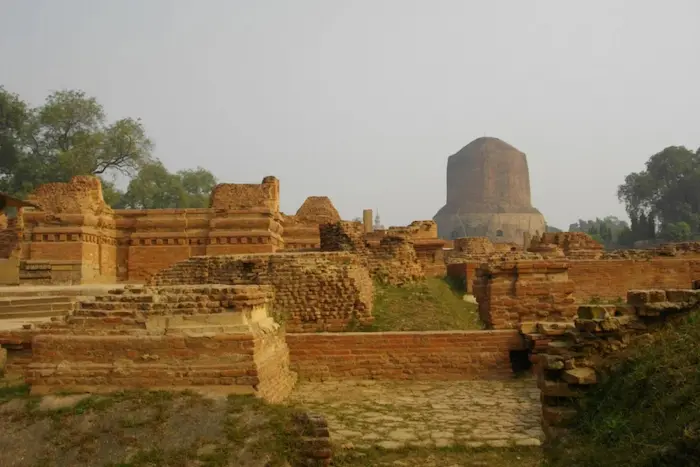
Why in News?
The Archaeological Survey of India (ASI) will revise the plaque at Sarnath to acknowledge the role of Jagat Singh, a member of the Benares royal family, in the 18th-century preservation of the Buddhist site. This change precedes a visit from a UNESCO team, as Sarnath is being considered for inclusion in the UNESCO World Heritage List.
The revision reflects a larger movement in India to decolonize historical narratives and highlight indigenous contributions to cultural heritage.
Key Takeaways:
Sarnath: A Buddhist Heritage Site
- Located 10 km from Varanasi, Uttar Pradesh.
- Site where Gautama Buddha gave his first sermon after attaining enlightenment (~528 BCE).
- The sermon included the Four Noble Truths and the Eightfold Path, laying the foundation of Buddhism.
- Known as the “Dhammacakkappavattana Sutta”, meaning the “Turning of the Wheel of Dharma.”
Mauryan Patronage: Ashoka’s Role
- Emperor Ashoka (3rd century BCE) visited Sarnath.
- Built several stupas and commissioned the Ashokan pillar topped with the Lion Capital.
- The Lion Capital of Ashoka is now the National Emblem of India.
Historical Attribution and Recent Developments:
| Previous Attribution | Revised Attribution |
|---|---|
| Credit for excavating and preserving Sarnath was largely given to British officials during the colonial period. | Now being corrected to acknowledge Jagat Singh, a local nobleman of Benares, who undertook major excavations in 1787–88. Jagat Singh’s early preservation efforts uncovered key Buddhist relics and structures. His contribution pre-dates British-led excavations, offering a more accurate historical timeline. |
Significance of the Revision:
- Cultural Decolonization: Recognizes indigenous custodianship over India’s ancient heritage.
- Historical Accuracy: Challenges colonial-era narratives that downplayed local efforts.
- Cultural Diplomacy: Enhances India’s bid for UNESCO recognition by showcasing local involvement in heritage protection.
- Reinforces national pride and identity rooted in civilizational history, not colonial interpretations.
Exam Connect – Possible Questions
Prelims
1. Sarnath is associated with which of the following major events in the life of Gautama Buddha?
A. Birth
B. Enlightenment
C. First Sermon
D.Death
Answer: C. First Sermon
2. The Lion Capital of Ashoka, now India’s national emblem, was originally located at:
A. Bodh Gaya
B. Lumbini
C. Rajgir
D. Sarnath
Answer: D. Sarnath
Mains
1. Discuss the significance of Sarnath in the development of Buddhist philosophy and its cultural heritage value for India. Why is it a strong candidate for UNESCO World Heritage status?
2. The revision of the Sarnath plaque by the ASI reflects a shift in historical narrative. Analyze the importance of decolonizing cultural history and the implications of recognizing indigenous contributions in heritage conservation.
3. Sarnath and the UNESCO Nomination: ASI Revises Historical Attribution – History & Culture
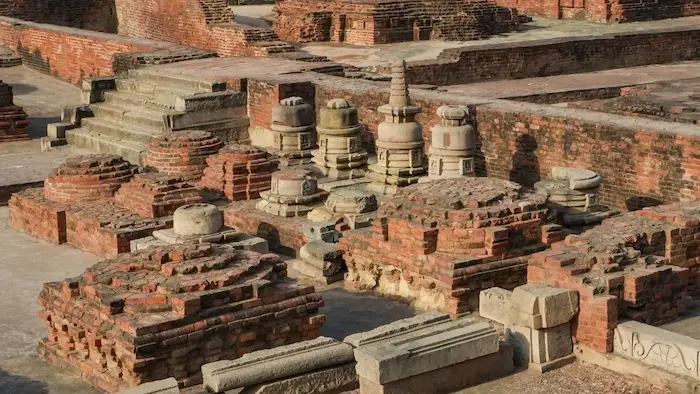
Why in News?
The Archaeological Survey of India (ASI) has decided to revise the historical plaque at Sarnath, recognizing the contribution of Babu Jagat Singh (1787–88) for uncovering the site’s archaeological significance. Until now, credit was largely given to British archaeologists, which overlooked indigenous involvement.
This revision is part of broader efforts to support Sarnath’s nomination for UNESCO World Heritage status and correct colonial-era historical narratives.
Key Takeaways
Location & Significance
- Sarnath is situated near Varanasi, Uttar Pradesh, at the confluence of the Ganga and Varuna rivers.
- It is one of Buddhism’s Four Holy Places, alongside Lumbini, Bodh Gaya, and Kushinagar.
- Here, Gautama Buddha delivered his first sermon (the Dhammacakkappavattana Sutta) in 528 BCE, setting in motion the Wheel of Dharma and establishing the Sangha (monastic community).
Key Monuments at Sarnath
| Monument | Significance |
|---|---|
| Dhamek Stupa | Built around 500 CE, marks the spot of Buddha’s first sermon. 39 m high and 28 m in diameter. |
| Ashoka Pillar | Commissioned by Emperor Ashoka (3rd century BCE); features the Lion Capital, now India’s national emblem. |
| Chaukhandi Stupa | An octagonal tower structure; later modified during the Mughal period. |
| Mulagandha Kuti Vihar | Modern temple with frescoes depicting the life of the Buddha. |
| Sarnath Archaeological Museum | Houses the original Lion Capital and other important Buddhist sculptures and relics. |
Archaeological Findings and Excavations
- Babu Jagat Singh, a nobleman from Benares, excavated the site in 1787–88, revealing the buried ruins of Buddhist structures.
- Excavations continued during the British period, but early efforts by locals were ignored or minimized in official records.
- B.R. Mani’s excavations (2013–14) suggest a Buddhist presence at Sarnath even before Ashoka’s reign, indicating continuous occupation and reverence.
Historical Role of Sarnath
- Under the Maurya, Kushan, and Gupta empires, Sarnath flourished as a major Buddhist learning and pilgrimage center.
- By the 7th century CE, it hosted over 30 monasteries and 3,000 monks.
- Pilgrims like Xuanzang and Faxian documented the site during their visits to India.
Contemporary Relevance and Plaque Revision
- The current ASI plaque at the site credits British archaeologists, ignoring indigenous efforts.
- Descendants of Jagat Singh have raised concerns, prompting ASI to announce a revised plaque to ensure historical accuracy.
- The revision is part of a larger movement to decolonize Indian heritage narratives and promote local agency in historical preservation.
- This also strengthens India’s case for UNESCO recognition, as it highlights community involvement in safeguarding heritage.
Exam Connect – Possible Questions
Prelims
1. The Dhamek Stupa at Sarnath is associated with:
A. Buddha’s Enlightenment
B. Buddha’s First Sermon
C. Buddha’s Birth
D. Buddha’s Mahaparinirvana
Answer: B. Buddha’s First Sermon
2. The Lion Capital of Ashoka, adopted as India’s National Emblem, was originally erected at:
A. Bodh Gaya
B.Sanchi
C. Sarnath
D. Lumbini
Answer: C. Sarnath
Mains
1. Critically examine the importance of Sarnath in the spread of Buddhism and its architectural and archaeological heritage. How does its nomination for UNESCO World Heritage status reinforce India’s soft power and cultural diplomacy?
2. The revision of the Sarnath plaque is part of India’s larger project of decolonizing its historical narratives. Discuss the importance of acknowledging indigenous contributions to the preservation of cultural heritage sites.
4. Nankana Sahib Pilgrimage: MHA Halts Travel Applications for 2025 – History & Culture
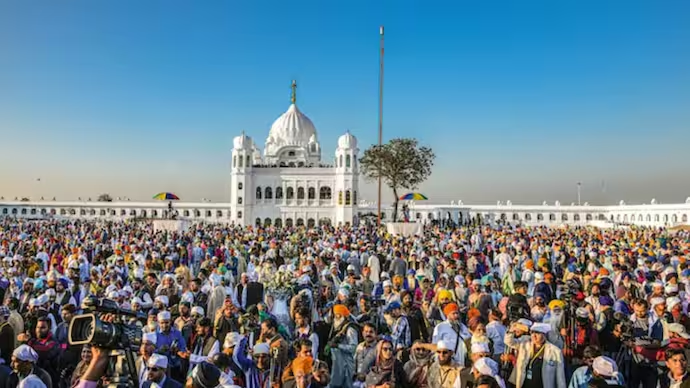
Why in News?
The Union Ministry of Home Affairs (MHA) has instructed all State governments to suspend the processing of applications by Sikh pilgrims intending to visit Nankana Sahib (Pakistan) for the Parkash Gurpurab (birth anniversary) celebrations of Guru Nanak Dev Ji in November 2025.
This move affects a significant annual religious pilgrimage, raising concerns within the Sikh community about restricted access to a sacred site.
Key Takeaways
Location & Significance
- Nankana Sahib is located near Lahore, in the Punjab province of Pakistan.
- It is the birthplace of Guru Nanak Dev Ji, the founder of Sikhism (born in 1469).
- Originally called Rai Bhoi Di Talwandi, it was renamed Nankana Sahib in honor of Guru Nanak.
Major Sikh Shrines at Nankana Sahib
| Gurdwara | Significance |
|---|---|
| Gurdwara Janam Asthan | Built over Guru Nanak’s birthplace by Maharaja Ranjit Singh (1818–1919). |
| Gurdwara Patti Sahib | Where Guru Nanak is believed to have learned the Gurmukhi alphabet. |
| Bal Leela, Kiara Sahib, Mal Ji Sahib, Tambu Sahib | Sites associated with Guru Nanak’s early life. |
| Shrines of Guru Arjan & Guru Hargobind | Located in the surrounding area, indicating extended Sikh historical presence. |
Guru Nanak Dev Ji – Life & Teachings
| Aspect | Details |
|---|---|
| Born | 1469 at Talwandi (now Nankana Sahib) |
| Enlightenment | Attained in 1496 at Sultanpur Lodhi |
| Key Message | “Ek Onkar Satnam” — There is One God, He is the Truth |
| Death | 1539 at Kartarpur Sahib (now in Pakistan); succeeded by Guru Angad Dev Ji |
Core Teachings – The Three Pillars of Sikhism:
- Naam Japna – Meditating on God’s name
- Kirat Karna – Honest and truthful living through hard work
- Vand Chhakna – Sharing resources with others, community service
Social Reforms Advocated
- Equality of all humans, regardless of caste, creed, or gender
- Rejection of rituals, idol worship, and caste hierarchy
- Promotion of Langar (community kitchen) and Seva (selfless service)
Cultural & Pilgrimage Relevance
- Nankana Sahib is central to Parkash Gurpurab celebrations, attracting thousands of Sikh pilgrims annually.
- The MHA directive impacts cross-border religious diplomacy and may affect India-Pakistan people-to-people relations.
- The issue highlights the sensitive nature of Sikh religious sites located in Pakistan and the role of the Indian government in facilitating access.
Exam Connect – Possible Questions
Prelims
1. Nankana Sahib, an important religious site for Sikhs, is located in which country?
A. India
B. Pakistan
C. Afghanistan
D. Nepal
Answer: C. Pakistan
2. Which of the following is not one of the “Three Pillars” of Sikhism as taught by Guru Nanak Dev Ji?
A. Naam Japna
B. Vand Chhakna
C. Kirat Karna
D. Bhakti Yoga
Answer: D. Bhakti Yoga
Mains
1. Discuss the historical and spiritual significance of Nankana Sahib in the Sikh religion. How do such cross-border pilgrimage sites influence religious diplomacy between India and Pakistan?
2. Guru Nanak Dev Ji’s teachings laid the foundation of Sikhism as a movement promoting social equality, devotion, and community service. Elaborate on the relevance of his philosophy in the present socio-cultural context of India.
5. Topography and Climate Change Fuel Himalayan Rains – Environment
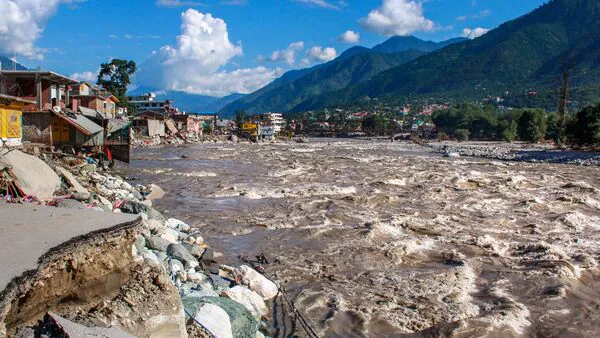
Why in News?
Recent heavy monsoon rains in Dehradun and other districts of Uttarakhand have triggered landslides, flash floods, mudslides, and claimed at least 15 lives. Similar extreme weather events have been reported across Himachal Pradesh and Jammu & Kashmir over the past month.
Although the Himalayas frequently experience intense rainfall during the monsoon, the rising frequency and severity of these events is being increasingly linked to climate change and topographical vulnerabilities.
Key Takeaways
Why Hilly Regions Receive More Rainfall
- The Western Himalayan region recorded:
- +34% surplus rainfall in August
- +67% above-normal rainfall in early September
- The topography forces moist air to rise rapidly, forming steep vertical clouds and intense localised precipitation.
- Example: Udhampur (J&K) received 630 mm in 24 hours — comparable to Rajkot’s annual rainfall.
Greater Disaster Risks in the Himalayas
| Plains | Himalayan Region |
|---|---|
| Rainwater mostly drains into river systems | Rainwater triggers landslides, flash floods, and mudslides |
| Infrastructure better adapted to rainfall | Fragile mountain slopes worsen damage |
| Floods more predictable | Cloudbursts often unpredictable and destructive Mandi, Kullu, and Kinnaur in Himachal Pradesh have witnessed repeated cloudburst-triggered disasters. |
Role of Climate Change
- Southward shift of Western Disturbances now overlaps more frequently with monsoon systems, increasing extreme rainfall.
- Melting Arctic ice is altering jet stream dynamics, contributing to:
- Heavier rainfall
- Longer dry spells
- Storms with higher moisture content
- Climate change is also shifting cloudburst patterns and intensifying their destructive potential.
Cloudburst Vulnerability in the Himalayas
- Cloudbursts are intense, short-duration rainfall events over a small area (typically >100mm in under an hour).
- Caused by interaction of:
- Tropical monsoon winds
- Mid-latitude westerlies
- In the Himalayan context, steep slopes, deforestation, and unregulated construction amplify risks.
Forecasting Challenges
- Current tools:
- Doppler Weather Radars (DWRs)
- Satellites (INSAT series, etc.)
- Numerical Weather Prediction Models
- Limitations:
- Inadequate coverage in remote/mountainous terrain
- Low spatial resolution for detecting hyper-localised events
- Short reaction windows for evacuation
- Need for Improvement:
- Better ground-based sensors
- High-resolution weather models
- Localized early warning systems
Conclusion
The intensification of rainfall and disaster frequency in the Himalayas is driven by a complex interplay of geography, climate change, and inadequate preparedness. Strengthening forecasting systems, enforcing zoning regulations, and restoring ecological buffers (like forests and wetlands) are crucial to protect vulnerable hill communities.
Exam Connect – Possible Questions
Prelims
1. Which of the following correctly explains a cloudburst?
A. A high-altitude snowstorm that causes avalanches
B. A rainfall event exceeding 100mm in one hour over a small area
C. A tornado event in mountainous regions
D. A monsoon wind reversal causing heavy downpour
Answer: B. A rainfall event exceeding 100mm in one hour over a small area
2. Which of the following factors contribute to extreme rainfall in the Himalayas?
1. Orographic lift
2. Southward shift of Western Disturbances
3. Arctic sea ice melting
4. Deforestation
Select the correct answer:
A.1 and 2 only
B. 2 and 3 only
C. 1, 2, and 3 only
D. All of the above
Answer: D. All of the above
Mains
1. Discuss the combined impact of topographical features and climate change on the frequency and intensity of extreme rainfall events in the Himalayan region. What policy measures are needed to build resilience?
2. Cloudbursts and flash floods are increasingly common in hill states like Uttarakhand and Himachal Pradesh. Explain the challenges in forecasting such events and suggest ways to improve disaster preparedness and mitigation.
6. GST 2.0 – Short-Term Pain, Possible Long-Term Gain – Economy

Why in News?
The Goods and Services Tax (GST), introduced as a destination-based tax system, was meant to unify indirect taxation and reduce inefficiencies like cascading taxes. However, multiple tax slabs, inverted duty structures, and compliance costs posed challenges.
Now, a major GST reform is set to take effect from September 22, 2025, aiming to simplify the rate structure, stimulate consumption, and improve ease of doing business.
Key Takeaways
Revised GST Rate Structure (2025)
| Category | New Rate |
|---|---|
| Essential goods/services | 0% |
| Majority of goods/services | 5% or 18% |
| Luxury/sin goods | 40% (Demerit Rate) About 80% of 546 reviewed goods will have reduced rates. Major beneficiaries: Textiles, Automobiles, Healthcare, and MSME sector |
.
Revenue Implications
- GST revenue (R) = Tax Rate (r) × Tax Base (E)
- Lower tax rates may increase demand, but not proportionally enough to maintain revenue levels.
- Estimated loss: ₹48,000 crore/year (Ministry of Finance).
Fiscal Challenges
- With nominal GDP growth underperforming, meeting GST targets becomes harder.
- This could strain both central and state budgets, especially those already facing fiscal deficits.
Structural Concerns Remain
Cascading Effects Not Fully Eliminated
- Exempted goods do not allow input tax credit (ITC).
- This leads to taxes on inputs going unrebated, increasing final prices and complicating compliance for businesses.
Inverted Duty Structures
- Some sectors still face higher input tax rates than output tax rates, creating refund backlogs and working capital issues.
Compliance Costs
- Although the rate structure is being simplified, GST compliance processes remain complex for small businesses.
- Better IT infrastructure and invoice-matching systems are required to ease this burden.
Macroeconomic Implications
Short-Term Gains
- Lower taxes on essential goods could:
- Boost disposable income
- Stimulate consumption, especially in low-income households
- Could support employment-intensive sectors, spurring short-term growth.
Long-Term Gains (If Well Managed)
- Higher consumption may eventually widen the tax base.
- Potential to enhance formalisation, if supported by:
- Improved compliance systems
- Investment in capacity-building
- Stable macroeconomic environment
Conclusion
The GST 2.0 reforms mark a bold step toward a simplified, consumption-driven tax structure. However, their success depends on:
- Managing fiscal risks
- Closing input credit loopholes
- Streamlining compliance
- Aligning reforms with productivity and investment policies
The reform brings short-term pain, particularly for government revenues, but could yield long-term gains if implementation challenges are addressed thoughtfully.
Exam Connect – Possible Questions
Prelims
1. Which of the following sectors is most likely to benefit from the GST 2.0 rate reduction?
A. Real estate
B. Automobiles
C.Defence
D. Banking
Answer: B. Automobiles
2. Under the new GST structure effective from September 2025, what is the rate proposed for luxury and sin goods?
A. 18%
B. 28%
C. 32%
D. 40%
Answer: D. 40%
Mains
1. GST 2.0 is an attempt to simplify the indirect tax system while enhancing consumption and compliance. Discuss the potential economic benefits and the fiscal trade-offs associated with the new GST structure.
2. Despite being a landmark reform, GST continues to face issues such as inverted duty structures, compliance burdens, and revenue instability. Evaluate these concerns in the context of the 2025 GST rate rationalisation.

